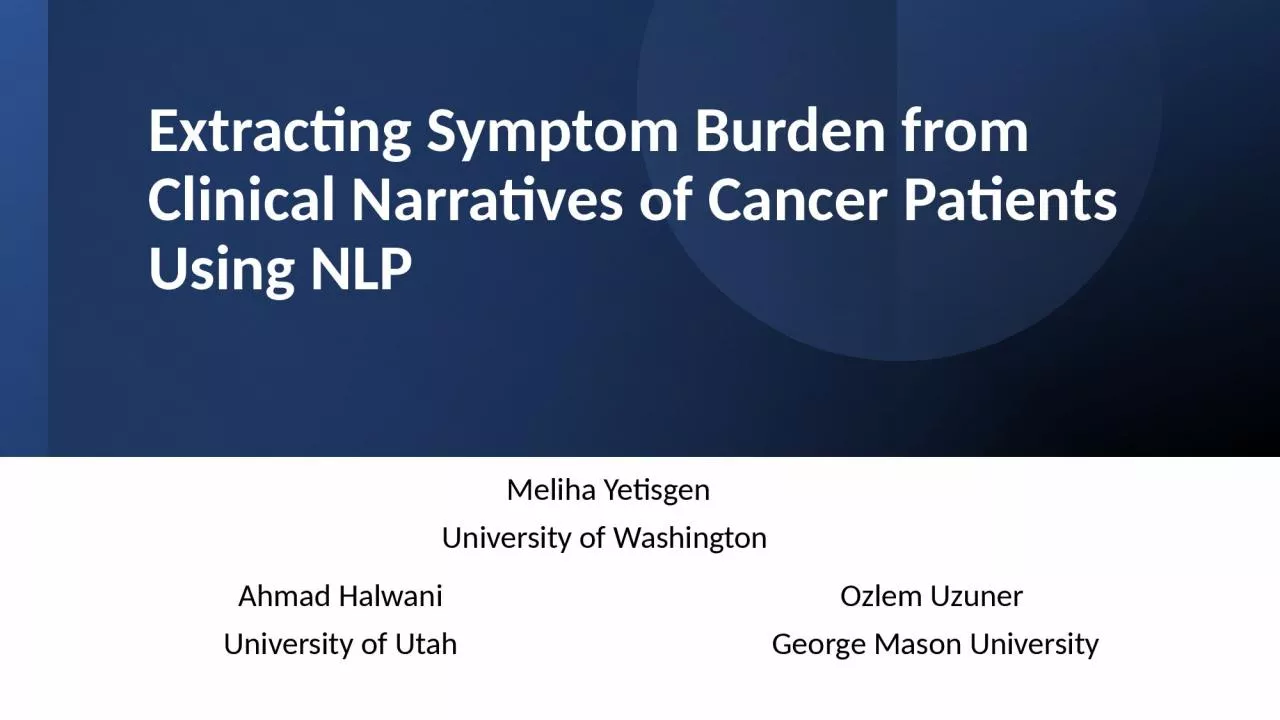

Meliha Yetisgen University of Washington Ahmad Halwani University of Utah Ozlem Uzuner George Mason University Treatment Diagnosis Remission Survivorship End of Life pain drowsiness ID: 935961
Download Presentation The PPT/PDF document "Extracting Symptom Burden from Clinical ..." is the property of its rightful owner. Permission is granted to download and print the materials on this web site for personal, non-commercial use only, and to display it on your personal computer provided you do not modify the materials and that you retain all copyright notices contained in the materials. By downloading content from our website, you accept the terms of this agreement.
Slide1
Extracting Symptom Burden from Clinical Narratives of Cancer Patients Using NLP
Meliha
Yetisgen
University of Washington
Ahmad Halwani
University of Utah
Ozlem
Uzuner
George Mason University
Slide2Treatment
DiagnosisRemission
SurvivorshipEnd of Life
pain
drowsiness
Shortness of breath
constipation
anxiety
anorexia
depression
tiredness
Most patients experience symptoms throughout their cancer journey leading to decreased quality of life
Only a minority of patients are referred to supportive oncology services.
Utilization of symptom burden information allows for prioritizing and facilitating patient referral to SOS, decreasing symptom burden in patients with cancer, improving QOL.
Symptom burden is documented in provider notes.
Anywhere between 25% to over 50% of patients on a single visit reported symptoms
Slide3Example provider noteSince last seen, Mr. Doe reports continued daily fatigue and lack of energy that is worse in the afternoon and limits his performance status; he can perform ADLs but tires easily and need to take a nap in the evening. Lower extremity
edema noted immediately after infusion (likely fluid overload) is now resolved. No chest pain or shortness of breath. His lymphadenopathy is improved but persists and his neck node continues to bother him. A week after his last cycle, he thought he felt a fever but did not take his temperature. This resolved by the next day. Appetite is decreased though oral intake is overall preserved. No chills. Daily
night sweats have resolved since starting treatment. No weight loss. The peripheral neuropathy he developed after cycle 1 (tingling in feet bilaterally, no weakness) is stable and does not bother him much.
Present symptomsAbsent symptoms
Present but Improved symptomsResolved symptoms
Present symptomsPresent symptomsPresent symptoms
Absent symptoms
Slide4Challenges Richness of language clinicians use in describing details of symptoms High cost of gold standard annotations needed to train and evaluate information extraction models Language use and reporting style differences across institutions
Slide5Aim 2: Detailed symptom extraction with NLPTwo major cancer centers:Seattle Cancer Care Alliance (SCCA)
Huntsman Cancer Institute (HCI)Two cancer patient populations:Prostate cancerDiffuse Large B Cell Lymphoma (DLBCL)Gold standard annotation with Active learning
Novel deep learning based text processing architectureEvaluation over two institutes for two cancer populations to ensure generalizability
Aim 1: Multi-institution gold standard annotation Goal: We will build Natural Language Processing technologies that can extract symptom information, along with their detailed attributes from clinical narratives.
Outcomes: Detailed symptom schema & annotation guidelines Active learning framework for sampling content rich notes to decrease the manual annotation effortFirst de-identified gold standard corpora annotated with symptoms
Outcomes:
Language modelsOpen source release of the NLP tools R21 Project – Start date May’2021
Slide6Aim 1 - Symptom Schema Trigger / Symptom Name (e.g., pain, headache) Assertion*Values: present, absent, possible, conditional, not-patient Change of state Values: no_change, worsened, improved, resolved Severity Values: mild, moderate, severe
Etiology Values: disease, treatment AnatomyCharacteristics DurationFrequency
Image source: https://www.cdc.gov/dengue/symptoms/index.html
Slide7Example Annotations
To capture this complex representation, many annotated training instances are required to train robust IE models
Slide8Gold standard annotation with Active LearningSample selection criteria:Informativeness: reduce classification uncertaintyDiversity: describe variation in selected samplesPrevious work on Social Determinants of Health gold standard corpora annotation
Lybarger K, Ostendorf M, Yetisgen M. Annotating social determinants of health using active learning, and characterizing determinants using neural event extraction. J Biomed Inform. 2021 Jan;113:103631.
Slide9Annotation planGold standard: Training set (75%) Random sampling + Active learningHeld-out Test set (25%)Random sampling: To capture true distribution of the dataset Ongoing work & Current progress: Datasets are created6 years of clinical notes of prostate cancer + DLBCL patients from SCCA and HCI
De-identified by an in-house de-identification toolAnnotation guidelines are finalized 6 medical students are working on annotation tasksQuery function design is in progress
Slide10Aim 2 - Information Extraction Framework Lybarger K, Ostendorf M, Thompson M, Yetisgen M. Extracting COVID-19 Diagnoses and Symptoms From Clinical Text: A New Annotated Corpus and Neural Event Extraction Framework. J Biomed Inform. 2021 Mar 26;:103761.
ArgumentPrecision
RecallF1Trigger0.810.850.83Assertion
0.770.800.79Change 0.450.050.09
Severity 0.450.310.37 Anatomy0.780.500.61
Characteristics0.660.250.36Duration0.540.560.55Frequency0.600.510.55
Baseline Framework
Slide11Thank you and Questions